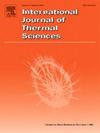Modelling the solidification process of supercooled phase change materials with high Prandtl number using the total enthalpy-based lattice Boltzmann method
IF 4.9
2区 工程技术
Q1 ENGINEERING, MECHANICAL
International Journal of Thermal Sciences
Pub Date : 2025-03-21
DOI:10.1016/j.ijthermalsci.2025.109881
引用次数: 0
Abstract
Modelling the supercooled solidification of PCMs is challenging due to the multi-value problem particularly for high Prandtl numbers (Pr). An improved total enthalpy-based lattice Boltzmann method is applied to simulate the solidification process of supercooled sodium acetate trihydrate (SAT, Pr = 40) in a vertical cylindrical container triggered by local cooling. The evolutions of the SAT temperature profile, solid fraction and particularly the solidification front are monitored, and the effects of the cold source temperature (Tcool) and the cooling area (l × l) are analyzed. The results show that the presented method accurately characterizes the supercooled solidification; decreasing Tcool from −5.5 °C to −7 °C reduces the induction time by 95.7 % and the discharging period by 11.1 %; increasing cooling area l × l from 2 × 2 cm2 to 8 × 8 cm2 also shortens the induction time from 11 s to 7 s and the discharging period by up to 500 s. The larger cooling area l × l accelerates the movement of the solidification front and also has a significant impact on its morphology. The present model proposes an alternative numerical method for predicting the discharging performance of the supercooled high-Pr PCMs inside containers.
求助全文
约1分钟内获得全文
求助全文
来源期刊

International Journal of Thermal Sciences
工程技术-工程:机械
CiteScore
8.10
自引率
11.10%
发文量
531
审稿时长
55 days
期刊介绍:
The International Journal of Thermal Sciences is a journal devoted to the publication of fundamental studies on the physics of transfer processes in general, with an emphasis on thermal aspects and also applied research on various processes, energy systems and the environment. Articles are published in English and French, and are subject to peer review.
The fundamental subjects considered within the scope of the journal are:
* Heat and relevant mass transfer at all scales (nano, micro and macro) and in all types of material (heterogeneous, composites, biological,...) and fluid flow
* Forced, natural or mixed convection in reactive or non-reactive media
* Single or multi–phase fluid flow with or without phase change
* Near–and far–field radiative heat transfer
* Combined modes of heat transfer in complex systems (for example, plasmas, biological, geological,...)
* Multiscale modelling
The applied research topics include:
* Heat exchangers, heat pipes, cooling processes
* Transport phenomena taking place in industrial processes (chemical, food and agricultural, metallurgical, space and aeronautical, automobile industries)
* Nano–and micro–technology for energy, space, biosystems and devices
* Heat transport analysis in advanced systems
* Impact of energy–related processes on environment, and emerging energy systems
The study of thermophysical properties of materials and fluids, thermal measurement techniques, inverse methods, and the developments of experimental methods are within the scope of the International Journal of Thermal Sciences which also covers the modelling, and numerical methods applied to thermal transfer.
 求助内容:
求助内容: 应助结果提醒方式:
应助结果提醒方式:


